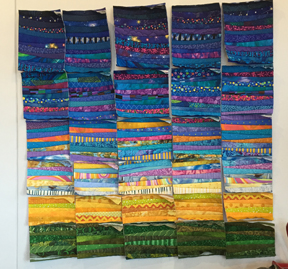Now I am not a fanatic about my work but still I think it deserves the respect of having the back look good even if you are the only person who will see it. This is the quilt "dawn" on my design board just waiting to get finished.
 |
| dawn--quilt--Ann Brauer--2015 |
To begin I take two small blocks that are going to be joined.
 |
| dawn--quilt--Ann Brauer--2015 |
I then put them right sides together, pin them and sew a seam. My machine is a 1965 Singer 281-3 which is beginning to get some wonderful signs of wear that adds character to it. (It actually survived when I lost my studio to Irene--pretty amazing isn't it? But I digress.)
 |
| dawn--quilt--Ann Brauer--2015 |
I open up the seam just to make sure I caught everything. Then I add a strip of fabric binding which will cover the seam allowance on the back. Probably I could do this process in one step but it always feels more secure with a double seam. This is a place you can use what you have and create your own style.
 |
| dawn--quilt--Ann Brauer--2015 |
I press the binding over the seam allowance and whip stitch it in place. Yes, this is not my favorite part of making the quilt. I want it done. But I turn on my favorite NPR station and hope that maybe Terry Gross has a great interview. What is Robin Young talking about today? You get the idea. Of course this is also a good time to dream of your next project.
 |
| dawn--quilt--Ann Brauer--2015 |
 |
| dawn--quilt--Ann Brauer--2015 |
Finally I sew the long rows together using the same technique. Note I have staggered the side where I press the bindings so it does not become too bulky.
 |
| dawn--quilt--Ann Brauer--2015 |
There you have it. A neat finish on the back. A quilt that lies flat.
Here is the snapshot of the quilt "dawn" the perfect project to finish at the end of the year. I had forgotten how wonderful the colors look together. Now I am wondering if I should make one for the studio also. Hmmm.
 |
| dawn--quilt--Ann Brauer--2015 |
Love your techniques. Thanks for the tutorial!
ReplyDeleteThank you Ann for the gift of showing pics and descriptions on how you assembled this gorgeous, awe-inspiring quilt.
ReplyDeleteI understand how the strips are sewn strip to strip and to the batting and back while working with small manageable-sized quilt blocks. How do you assemble the strips for an art quilt that is not built in blocks? Your Pluto or Sunrise for example.
My guess is that you sew many strips of fabrics together into a long length, (the width+ of your quilt). Then take this long pre-assembled piece and sew onto the last strip/batting/backing of the quilt. (The batting and backing are the size of your finished quilt, untrimmed of course.) So your building your quilt in full width layers as you did for each of the small blocks as with the Dawn quilt.
Did I guess right?
Thank you Ann for the gift of showing pics and descriptions on how you assembled this gorgeous, awe-inspiring quilt.
ReplyDeleteI understand how the strips are sewn strip to strip and to the batting and back while working with small manageable-sized quilt blocks. How do you assemble the strips for an art quilt that is not built in blocks? Your Pluto or Sunrise for example.
My guess is that you sew many strips of fabrics together into a long length, (the width+ of your quilt). Then take this long pre-assembled piece and sew onto the last strip/batting/backing of the quilt. (The batting and backing are the size of your finished quilt, untrimmed of course.) So your building your quilt in full width layers as you did for each of the small blocks as with the Dawn quilt.
Did I guess right?